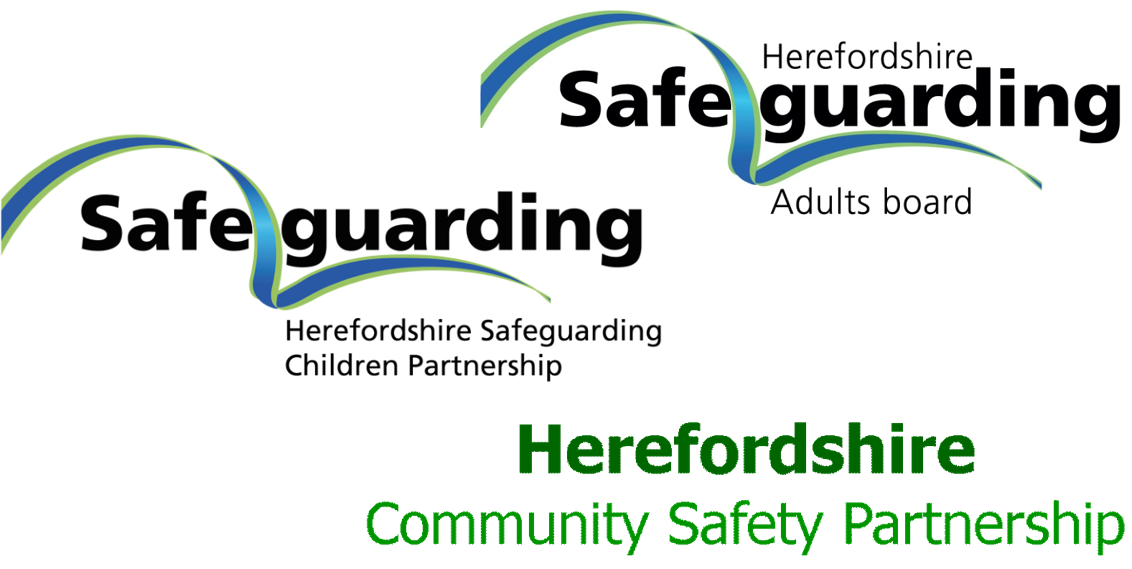Get Safe – Contextual Safeguarding

Contextual Safeguarding is a recognition that children and young people may be at significant risk of harm due to external factors outside of the family home. In Herefordshire we have adopted the GET SAFE model which aims to work in collaboration with our multi-agency partners to keep children and young people safe from contextual safeguarding. GET SAFE stands for:
Gangs
Sexual Exploitation
Trafficking
Modern Day Slavery
Absent or Missing
Forced Marriage
Criminal Exploitation
Additionally the approach will include: County Lines, Honour Based Violence (HBV), Female Genital Mutilation (FGM) and Radicalisation
The GET SAFE Partnership is committed to tackling Child Exploitation and supporting victims and their families who experience this. Our Herefordshire partnership includes: West Mercia Police, a range of NHS health services, Education, Youth Justice, Early Help services and our voluntary sector all working together with district councils and other support agencies.
Where incidences of child exploitation are uncovered in Herefordshire, immediate action must be taken to involve the police and make an urgent referral to children’s social care to safeguard the child or children involved. Details of how to do this can be found on our Concerned about a child page.
The GET SAFE model will work with multi-agency partners to identify but also build a robust support pathway with each child. Depending on level of concern the GET SAFE process will ensure each child has robust support utilising Early Help services, community services, health, police and education.
For additional guidance and templates for practitioners, visit our policies and procedures here: Exploitation tools and pathways (procedures.org.uk)
Information about contextual safeguarding for young people, parents and carers:
- PACE (Parents against exploitation) support parents and carers whose children are being exploited by offenders outside of the family.
- NWG Network information for parents and carers.
- Visit our Youth Hub webpage for more links and support for children and young people – Youth Hub: Exploitation and Crime
You may also find useful information and resources in the “More Information, Helplines and Support for Child Exploitation” below.
Information for professionals:
- Contextual safeguarding website
- Positive Language: Child Sexual and/or Criminal Exploitation Guidance For Professionals (The Childrens Society)
- Child Sexual Exploitation: Definition and a guide for practitioners (GOV.UK)
- Visit the West Midlands Regional Child Protection Procedures for Get Safe policies and procedures and additional guidance on specific topics. Select “Content” and “Herefordshire”
Child exploitation is where someone takes advantage of a child for their own benefit. It can take many forms, including:
Criminal exploitation – where person takes advantage of a child by benefitting from the child’s involvement in criminal activities, including organised crime. This includes County Lines drug trafficking.
Sexual exploitation – where person takes advantage of a child sexually, for their own gain. This can include physical or non-physical acts, such as exposing a child to sexual behaviour or taking sexualised images of children.
Labour exploitation – where a person takes advantage of a child for labour purposes, for example working in restaurants, garages, gardening, or nail salons.
Domestic servitude – where a person takes advantage of a child for domestic help, for example to look after other children in the home, caring for older people, or to help with cooking and cleaning.
This is not an exhaustive list, as child exploitation can take many forms.
These are some of the signs of exploitation, although this is not an exhaustive list:
- Becoming Secretive – Increasing or secretive mobile phone or other devise use
- Online Behaviour – Excessive amount of time online and being secretive about time online
- Social Changes – A significantly older ‘boyfriend’ or ‘friend’ or lots of new friends
- Change in behaviour – becoming secretive, argumentative, aggressive, disruptive, quiet, withdrawn
- New Things – Having unexplained gifts or new possessions such as clothes, jewellery, mobile phones or having money or access to other goods such as alcohol that can’t be accounted for
- Going AWOL – Regularly missing from home or school, for unexplained periods of time and or staying out late or all night.
- Becoming Distant – Are they showing signs of harm or depression? Are there unexplained absences from school?
- Unusual items – Have you found unusual items in the house such as a balaclava, debit cards, drugs, drug paraphernalia or weapons?
- Calls and contacts – Are they receiving calls and messages more frequently and at all hours of the day? Do they react immediately when they receive the message? Do they have a new group of friends who you don’t know or who may seem older?
- Journeys – Have you found evidence such as bus or train tickets, which show that they have been making trips to places they wouldn’t normally go? Do they often leave home without an explanation of where they are going? Do they go out or come home at unusual or very regular times?
Child trafficking is where a child is moved for the purposes of exploitation. A child may be brought to or from another country, or moved within the UK, for the intended purpose of exploiting them. If child trafficking is suspected, a referral to the National Referral Mechanism must be made, in addition to following safeguarding procedures to protect the child.
Think You Know – CEOP site for children age 4-18, with information about child exploitation and online safety. There is also a section for professionals
The Children’s Society has a number of Toolkits and resources on different topics related to exploitation.
WMRSASC supports survivors of sexual violence in Herefordshire and run a confidential helpline.
Stop it Now! Have a confidential helpline and information on their website about child sexual exploitation.
NSPCC Information About Grooming
Tea & Consent Video – a short video explaining consent.
NWG Network information for children and young people.
You & Co – Information for young people having to attend court.
This document can be used by families, professionals and community members to help understand what intelligence is and how it can be reported: Capturing and Reporting Intelligence: Child Sexual and/or Criminal Exploitation Guidance for Families, Professionals and the Community.
The West Mercia Police Exploitation Intelligence Report Form can be used to report intelligence to the police in Herefordshire – See West Mercia Police Exploitation Intelligence Report Form
Below are some recommended Child Exploitation films and resources for schools. These can be very useful tools in raising awareness of child exploitation.
CSE BAIT Resource for Secondary Schools and FE Colleges
The BAIT resource pack has been specifically designed for use by schools and colleges, targeted at 14 -17 year old students, to raise awareness and understanding of the dangers of Child Exploitation.
The BAIT resource pack, which includes a DVD and work book, has been distributed to secondary schools and Further Education colleges in Herefordshire.
My New Friend – grooming and sexual exploitation of boys and girls
My New Friend is a short YouTube video that was produced to raise awareness of grooming and Child Sexual Exploitation of boys and young men
NSPCC
‘It’s Not Okay’ teaching resource about positive relationships for ages 11+
‘PANTS‘ resources for children aged 4-8 years
The Herefordshire Safeguarding Children Partnership has created the GET SAFE Partnership and is committed to tackling Child Exploitation and supporting victims and their families who experience this. Our Herefordshire partnership includes: West Mercia Police, a range of NHS health services, Education, Youth Justice, Early Help services and our voluntary sector all working together with district councils and other support agencies.
There is also an operational Prevent and Disrupt Group. This is a multi-agency group that works together to share information, including about hot spots/places and themes around exploitation
